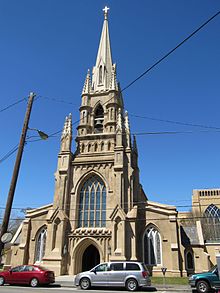Diocese of South Carolina | |
|---|---|
 | |
| Location | |
| Country | United States |
| Ecclesiastical province | Province IV |
| Headquarters | Charleston SC |
| Statistics | |
| Parishes | 40[1] |
| Congregations | 40 (2021) |
| Members | 9,254 (2021) |
| Information | |
| Denomination | Episcopal Church |
| Established | May 12, 1785 |
| Cathedral | Grace Church Cathedral |
| Current leadership | |
| Bishop | Ruth Woodliff-Stanley |
| Map | |
 Location of the Diocese of South Carolina | |
| Website | |
| episcopalchurchsc.org | |

The Episcopal Diocese of South Carolina (EDOSC), known as The Episcopal Church in South Carolina from January 2013 until September 2019, is a diocese of the Episcopal Church. The diocese covers an area of 24 counties in the eastern part of the U.S. state of South Carolina. The see city is Charleston, home to Grace Church Cathedral and the diocesan headquarters. The western portion of the state forms the Episcopal Diocese of Upper South Carolina. As a diocese of the Episcopal Church, the Diocese of South Carolina is part of the worldwide Anglican Communion and traces its heritage to the beginnings of Christianity.[2]
In a 2012 schism, Bishop Mark Lawrence and the majority of the leaders and parishes of the historical Diocese of South Carolina departed from the Episcopal Church. Lawrence's group considered their departure to be an official act of the diocese. The Episcopal Church disagreed, noting that its constitution and canons do not allow a diocese to unilaterally withdraw, and recognized the remaining parishes and individuals as its continuing diocese, under the new name "Episcopal Church in South Carolina". Charles G. vonRosenberg was installed as the new bishop provisional of the diocese in January 2013.[3] Lawrence's group joined the Anglican Church in North America, and later became known as the Anglican Diocese of South Carolina (ADOSC).
Both parties claimed ownership of diocesan property, including not only church buildings but also the name "Episcopal Diocese of South Carolina", and related names and marks. These claims were the subject of protracted legal battles. On August 2, 2017, the South Carolina Supreme Court held in a split decision that twenty-nine of the parishes in the lawsuit and the St. Christopher Camp and Conference Center are the property of the Episcopal Church in South Carolina and must be returned, but that the seven remaining parish properties are owned by the Anglican Diocese of South Carolina.[4] The South Carolina Supreme Court's decision did not answer the question of who owned the use of the name "Episcopal Diocese of South Carolina", and other associated marks.[4] On September 19, 2019, a federal court awarded the names and intellectual property to the Episcopal Church and its South Carolina diocese.[5][6] In 2022, a final ruling of the South Carolina Supreme Court awarded eight parish properties from the ADOSC to the EDOSC, and the two dioceses agreed to settle all remaining litigation over diocesan property, names and seals, with the EDOSC retaining the name, seal and most of the property.[7]
As of 2021[update], the Episcopal Diocese of South Carolina is led by Ruth Woodliff-Stanley, who was consecrated as the 15th bishop of the diocese on October 2, 2021.[8]
- ^ "Find a Church".
- ^ "The Episcopal Church in South Carolina". The Episcopal Church in South Carolina. Retrieved 6 July 2018.
- ^ "Rebuild Episcopal Church in South Carolina, new bishop says". www.ecumenicalnews.com. 27 January 2013. Retrieved 6 July 2018.
- ^ a b Berry Hawes, Jennifer; Adam, Parker (2 August 2017). "State Supreme Court rules The Episcopal Church can reclaim 29 properties from breakaway parishes". Retrieved 6 July 2018. [1]
- ^ "Federal judge rules in favor of Episcopal Church in South Carolina in trademark infringement case". 19 September 2019.
- ^ Hoff, Patrick (October 1, 2019). "Episcopal Church wins federal trademark suit". Charleston Regional Business Journal. Retrieved 2022-07-25.
- ^ Gryboski, Michael (26 September 2022). "Anglicans, Episcopal Church reach settlement on yearslong $500 million property dispute". Christian Post. Archived from the original on 27 September 2022. Retrieved 27 September 2022.
- ^ Heath, Ellison (2 October 2021), First woman ordained as bishop of Episcopal Diocese of South Carolina, Charleston: WCIV (published 2021-10-02), retrieved 2021-10-03